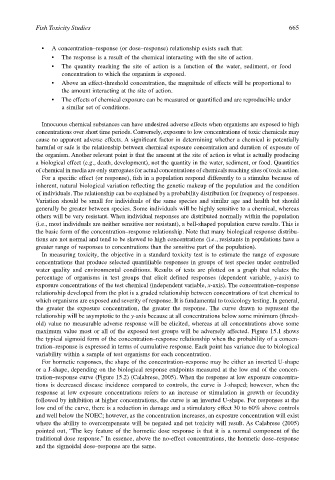Page 685 - The Toxicology of Fishes
P. 685
Fish Toxicity Studies 665
• A concentration–response (or dose–response) relationship exists such that:
• The response is a result of the chemical interacting with the site of action.
• The quantity reaching the site of action is a function of the water, sediment, or food
concentration to which the organism is exposed.
• Above an effect-threshold concentration, the magnitude of effects will be proportional to
the amount interacting at the site of action.
• The effects of chemical exposure can be measured or quantified and are reproducible under
a similar set of conditions.
Innocuous chemical substances can have undesired adverse effects when organisms are exposed to high
concentrations over short time periods. Conversely, exposure to low concentrations of toxic chemicals may
cause no apparent adverse effects. A significant factor in determining whether a chemical is potentially
harmful or safe is the relationship between chemical exposure concentration and duration of exposure of
the organism. Another relevant point is that the amount at the site of action is what is actually producing
a biological effect (e.g., death, development), not the quantity in the water, sediment, or food. Quantities
of chemical in media are only surrogates for actual concentrations of chemicals reaching sites of toxic action.
For a specific effect (or response), fish in a population respond differently to a stimulus because of
inherent, natural biological variation reflecting the genetic makeup of the population and the condition
of individuals. The relationship can be explained by a probability distribution for frequency of responses.
Variation should be small for individuals of the same species and similar age and health but should
generally be greater between species. Some individuals will be highly sensitive to a chemical, whereas
others will be very resistant. When individual responses are distributed normally within the population
(i.e., most individuals are neither sensitive nor resistant), a bell-shaped population curve results. This is
the basic form of the concentration–response relationship. Note that many biological response distribu-
tions are not normal and tend to be skewed to high concentrations (i.e., resistants in populations have a
greater range of responses to concentrations than the sensitive part of the population).
In measuring toxicity, the objective in a standard toxicity test is to estimate the range of exposure
concentrations that produce selected quantifiable responses in groups of test species under controlled
water quality and environmental conditions. Results of tests are plotted on a graph that relates the
percentage of organisms in test groups that elicit defined responses (dependent variable, y-axis) to
exposure concentrations of the test chemical (independent variable, x-axis). The concentration–response
relationship developed from the plot is a graded relationship between concentrations of test chemical to
which organisms are exposed and severity of response. It is fundamental to toxicology testing. In general,
the greater the exposure concentration, the greater the response. The curve drawn to represent the
relationship will be asymptotic to the y-axis because at all concentrations below some minimum (thresh-
old) value no measurable adverse response will be elicited, whereas at all concentrations above some
maximum value most or all of the exposed test groups will be adversely affected. Figure 15.1 shows
the typical sigmoid form of the concentration–response relationship when the probability of a concen-
tration–response is expressed in terms of cumulative response. Each point has variance due to biological
variability within a sample of test organisms for each concentration.
For hormetic responses, the shape of the concentration–response may be either an inverted U-shape
or a J-shape, depending on the biological response endpoints measured at the low end of the concen-
tration–response curve (Figure 15.2) (Calabrese, 2005). When the response at low exposure concentra-
tions is decreased disease incidence compared to controls, the curve is J-shaped; however, when the
response at low exposure concentrations refers to an increase or stimulation in growth or fecundity
followed by inhibition at higher concentrations, the curve is an inverted U-shape. For responses at the
low end of the curve, there is a reduction in damage and a stimulatory effect 30 to 60% above controls
and well below the NOEC; however, as the concentration increases, an exposure concentration will exist
where the ability to overcompensate will be negated and net toxicity will result. As Calabrese (2005)
pointed out, “The key feature of the hormetic dose response is that it is a normal component of the
traditional dose response.” In essence, above the no-effect concentrations, the hormetic dose–response
and the sigmoidal dose–response are the same.

